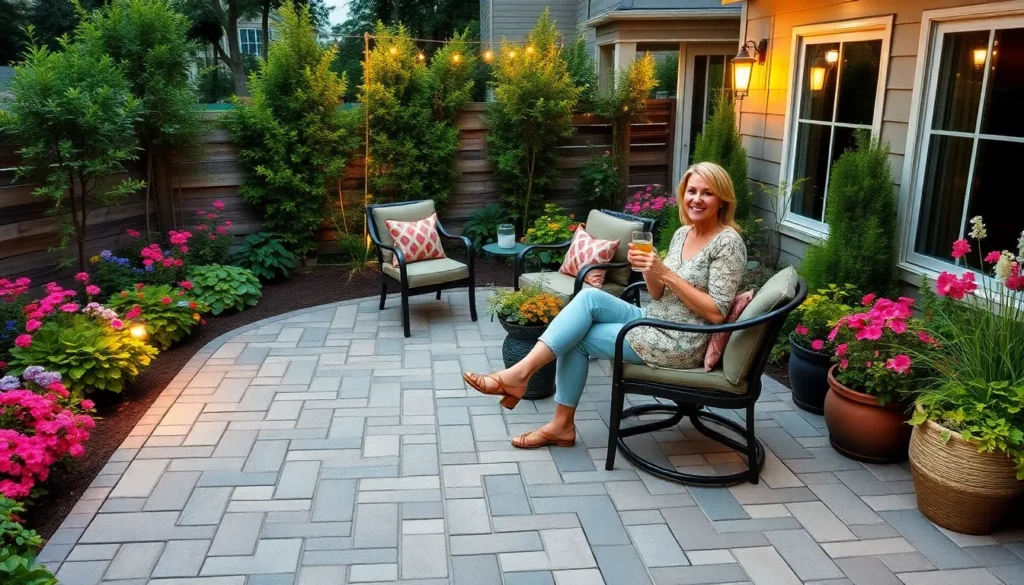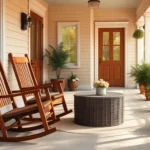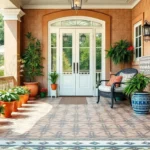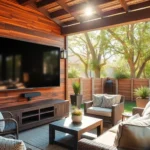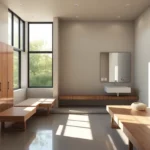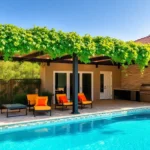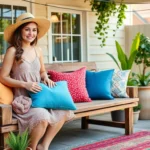Dreaming of the perfect outdoor entertaining space? A 24×24 paver patio offers the ideal canvas for creating your backyard oasis. This generous 576-square-foot area provides ample room for dining sets, lounging furniture, and memorable gatherings while maintaining that intimate feel we all crave in our outdoor spaces.
We’ve discovered that 24×24 patios strike the perfect balance between functionality and affordability. They’re large enough to accommodate various design elements without overwhelming smaller yards or very costly. Whether you’re envisioning elegant travertine, rustic brick, or modern concrete pavers, this size delivers maximum impact with manageable installation costs.
From Mediterranean-inspired retreats to contemporary minimalist designs, we’ll explore stunning paver patterns, color combinations, and layout ideas that transform ordinary backyards into extraordinary outdoor living spaces. Get ready to discover how this versatile patio size can become the heart of your home’s outdoor entertainment area.
Classic Herringbone Pattern With 24×24 Pavers
Creating a striking herringbone pattern with 24×24 pavers transforms your outdoor space into a sophisticated retreat. This timeless arrangement showcases the beauty of large format pavers while delivering exceptional visual impact across your 576 square foot entertaining area.
Traditional Brick Red Herringbone Design
Warmth radiates from traditional brick red pavers arranged in the classic herringbone configuration. We recommend selecting pavers with subtle color variations like Belgard’s Holland Stone in Autumn Blend or Cambridge Pavingstones in Brick Red to create natural depth. Installing these pavers at 90 degree angles produces the distinctive zigzag pattern that draws the eye across your patio surface.
Border treatments enhance the traditional appeal by framing your herringbone field with soldier course edges. We suggest using matching brick red pavers or contrasting charcoal gray borders to define the space. Maintenance remains minimal with sealed brick red pavers requiring only annual cleaning and resealing every 3 to 5 years.
Modern Gray Herringbone Layout
Contemporary appeal emerges when gray pavers form geometric herringbone patterns across your 24×24 space. We favor neutral tones like Techo Bloc’s Blu 60 in Sandlewood Gray or Unilock’s Umbriano in Winter Marvel for their clean aesthetic. Precision becomes crucial during installation as the large format pavers require exact spacing to maintain pattern integrity.
Lighting integration complements modern gray herringbone designs through strategically placed LED strips between select paver joints. We install low voltage lighting systems that highlight the pattern’s angular beauty during evening gatherings. Furniture placement works seamlessly with gray herringbone layouts as the neutral backdrop accommodates both dark and light outdoor furniture pieces.
Mixed Material Herringbone Combination
Creative flexibility allows combining different paver materials within the herringbone pattern for unique visual texture. We blend natural stone pavers like travertine with concrete pavers in complementary colors to achieve stunning contrasts. Size coordination requires careful planning when mixing 24×24 pavers with 12×24 accent pieces to maintain pattern continuity.
Color transitions create focal points by alternating warm and cool toned pavers throughout the herringbone arrangement. We select materials with similar thickness ratings like 2.36 inch concrete pavers paired with matching thickness natural stone options. Installation complexity increases with mixed materials requiring experienced contractors familiar with different expansion rates and base preparation requirements.
Contemporary Linear Stack Pattern Ideas
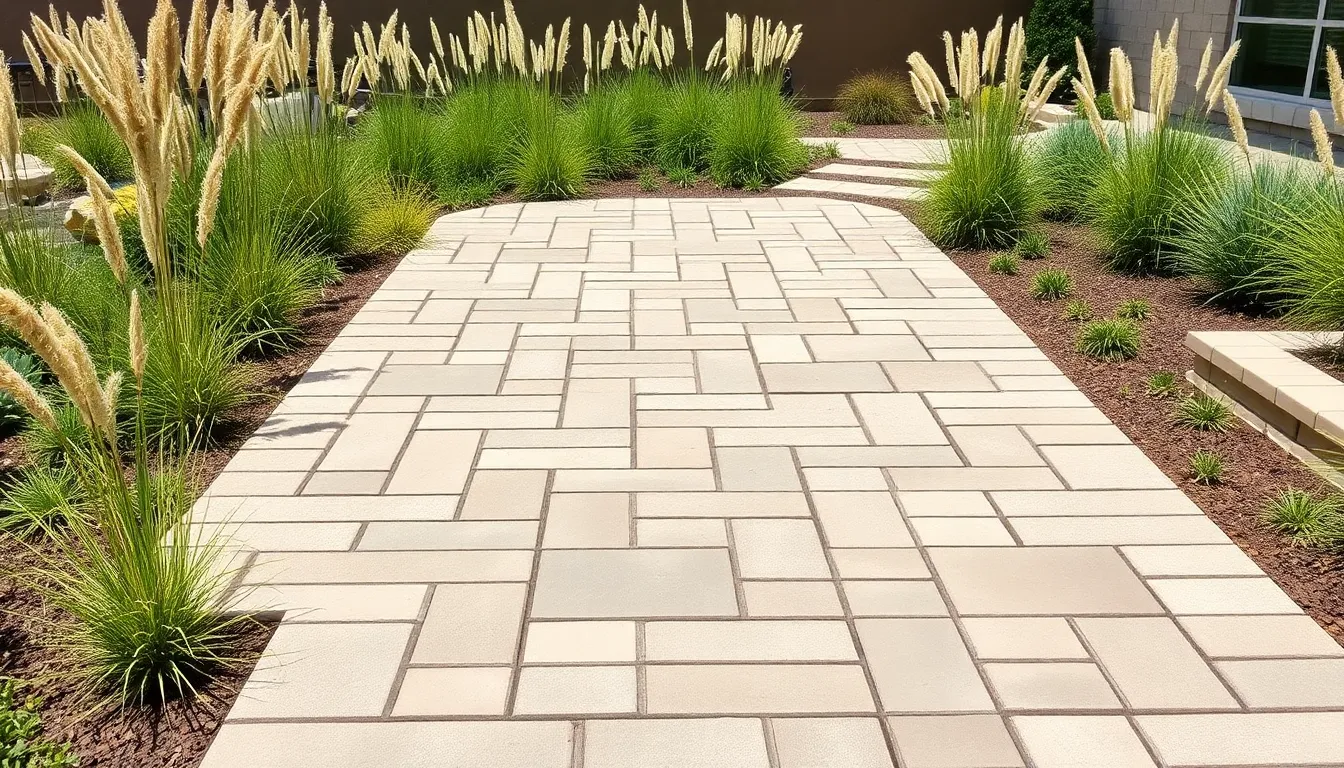
Contemporary linear stack patterns offer a refreshing departure from complex herringbone designs, emphasizing clean geometry and architectural precision. We’ve found that this approach creates sophisticated outdoor spaces that complement modern home designs while maintaining timeless appeal.
Straight Running Bond Layout
Running bond transforms traditional masonry techniques for large format pavers. Each row of 24×24 pavers staggers so joints offset by half a paver length from adjacent rows, creating subtle rhythm without sacrificing the linear aesthetic. This classic pattern provides structural stability while introducing balanced visual interest across your patio surface.
Installation requires precise measurement to maintain consistent offsets. We recommend using string lines and spacers to ensure each row aligns perfectly with the established pattern. The staggered joints distribute weight evenly, making this layout particularly suitable for high traffic areas and heavy outdoor furniture placement.
Color selection amplifies the running bond’s natural flow. Neutral tones like charcoal gray or warm beige emphasize the pattern’s linear movement, while contrasting grout lines can highlight the geometric arrangement. Mixed color palettes create depth and prevent the large format from appearing monotonous.
Offset Linear Pattern Design
Offset patterns create ever-changing visual interest through strategic irregularity. Unlike traditional running bond, this design uses offsets less than half a paver length, producing a more contemporary feel that breaks strict symmetry while preserving linear integrity. Custom offset measurements allow personalization based on your exact design preferences.
Strategic planning determines the pattern’s overall impact. We suggest creating mock layouts using cardboard templates to visualize different offset distances before installation begins. Quarter length offsets produce subtle variation, while third length offsets create more pronounced rhythm across the patio surface.
Contrasting elements enhance the offset pattern’s uniqueness. Mixed colors within the same paver size emphasize the irregular placement, while varying textures add tactile interest. Ground cover plants or decorative pebbles between select joints can soften the hardscape and create organic contrast points.
Geometric Linear Arrangements
Geometric combinations expand design possibilities beyond single paver layouts. Large 24×24 pavers integrate with rectangles, smaller squares, or accent strips to form custom patterns like grids, checkerboards, or modern tessellations. These arrangements allow complete customization while maintaining the clean lines characteristic of contemporary design.
Planning ensures successful geometric integration. We recommend sketching potential layouts on graph paper, considering furniture placement and traffic flow patterns. Mathematical relationships between different paver sizes prevent awkward cuts and maintain pattern consistency throughout the installation.
Industry elements complete geometric arrangements. Strategic placement of ornamental grasses, low growing succulents, or river rock between geometric sections creates visual breaks and adds organic texture. These natural elements prevent geometric patterns from appearing too rigid while improving the overall outdoor living experience.
Elegant Circular And Curved Patio Designs
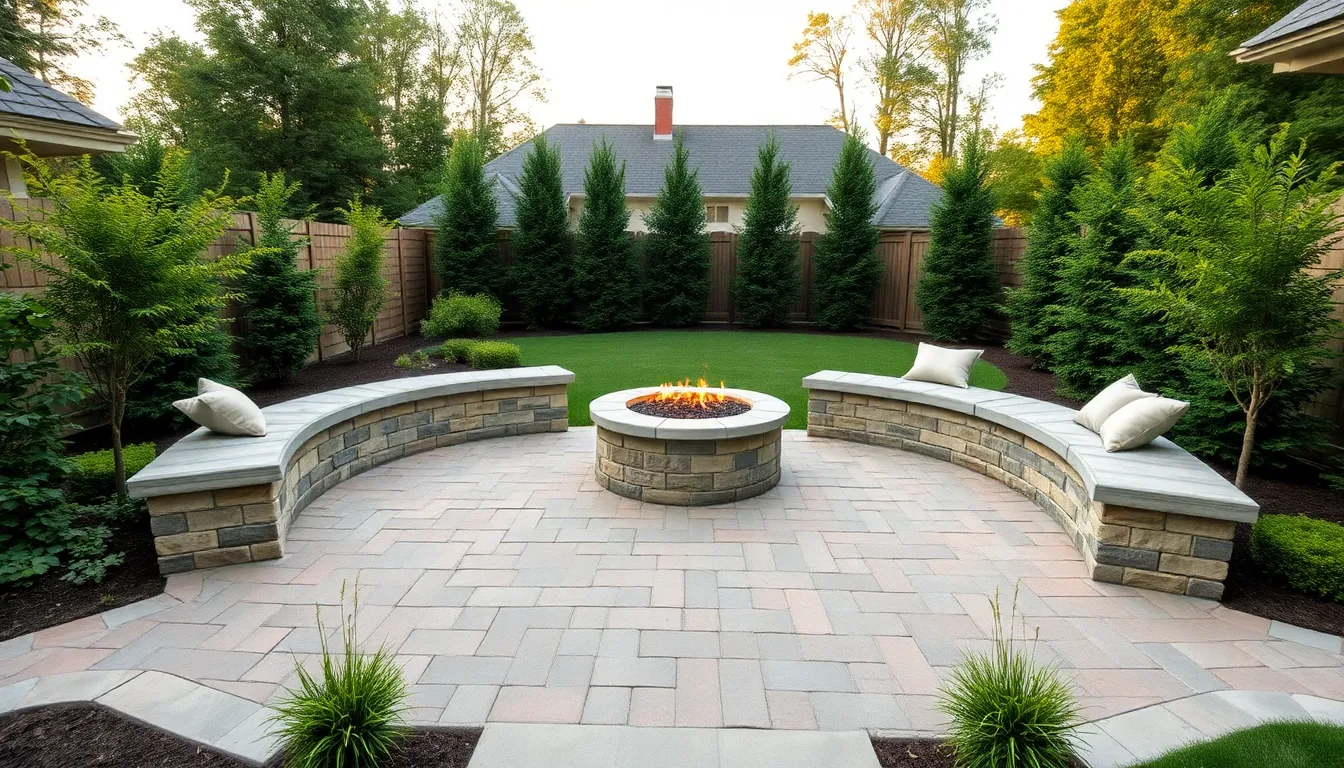
Moving beyond linear patterns, we can create stunning organic designs that complement your industry’s natural flow. Curved patio layouts offer sophisticated alternatives to traditional rectangular designs.
Full Circle Paver Patio Layout
Full circle patios transform your 24×24 space into a dramatic focal point that draws the eye and creates natural gathering areas. These layouts provide approximately 314 square feet of usable space when designed with a 20-foot diameter circle, fitting perfectly within our 576 square foot patio area. We recommend positioning the circular design to complement existing industry features like mature trees or garden beds.
Planning your circular layout requires precise calculations using the πr² formula to maximize your available space. Start by marking the center point of your intended circle, then use a string compass method to ensure perfect symmetry. Consider incorporating a contrasting border ring around the perimeter to define the circular shape and add visual depth to the overall design.
Installation techniques for circular patterns demand careful attention to paver cutting and fitting along curved edges. We suggest using wet saws with diamond blades to achieve clean cuts that follow your marked curve lines. Double circular patterns work exceptionally well in larger 24×24 spaces, creating ever-changing visual interest while maintaining functional walkways between the circles.
Semi-Circular Entertainment Area
Semi-circular patios maximize your entertainment potential by creating intimate gathering spaces that connect seamlessly to your home’s architecture. This half-moon design typically extends from an existing structure or rectangular patio section, offering expanded seating areas without overwhelming smaller yard spaces. We’ve found these layouts work particularly well when positioned to capture evening sunlight or frame scenic views.
Built-in features integrate beautifully with semi-circular designs to enhance your outdoor entertainment experience. Consider incorporating curved built-in benches that follow the patio’s arc, or position a central fire pit to create a natural conversation circle. Curved dining sets complement the organic shape while maximizing seating capacity within the available space.
Strategic placement of your semi-circular area can create distinct zones within your larger patio design. We recommend using the curved section for dining or lounging while reserving rectangular sections for traffic flow or utility areas. This zoning approach helps organize your outdoor space while maintaining visual cohesion throughout the entire 24×24 area.
Curved Border Accent Patterns
Curved border accents soften harsh rectangular edges while adding sophisticated architectural interest to your paver patio design. These decorative elements can frame your central patio area using contrasting paver colors or materials, creating layered visual texture that draws attention to exact zones. We often incorporate herringbone or basketweave patterns within these curved borders to maximize visual impact.
Color contrast strategies enhance curved border designs by emphasizing the flowing lines against your main patio surface. Consider using darker pavers for the curved borders with lighter colors in the central areas, or reverse this approach for different visual effects. Natural stone pavers with rounded edges complement curved designs better than sharp-edged concrete alternatives.
Installation planning for curved borders requires careful measurement and mock layouts before beginning the actual work. We recommend creating templates using flexible materials like garden hoses or rope to visualize different curve radii and border widths. Combine your curved borders with planted areas or decorative stone features to create seamless transitions between hardscape and industry elements.
Multi-Level Paver Patio Configurations
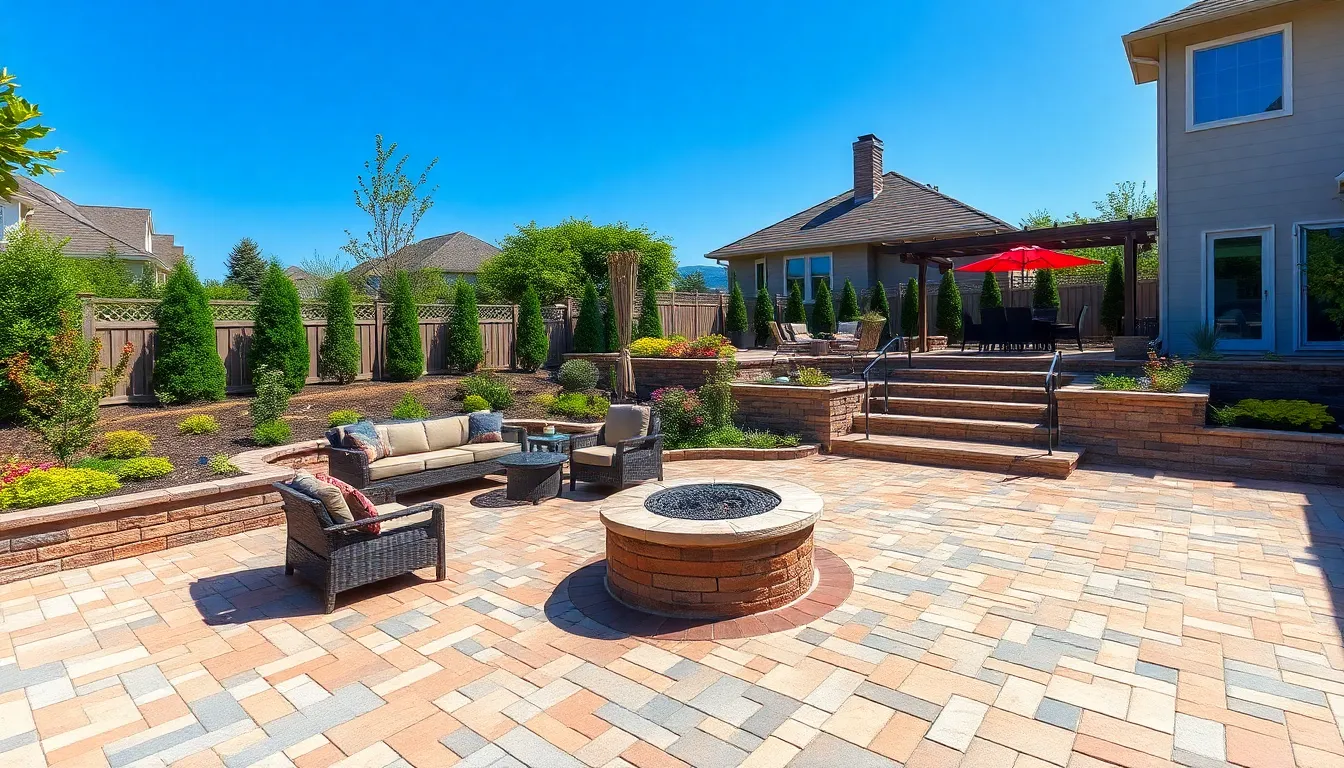
Moving beyond flat paver arrangements, we can transform our 24×24 patio space by incorporating vertical elements that add depth and functionality. Multi-level configurations maximize the potential of our 576 square feet by creating distinct zones for different activities.
Stepped Terrace Design
Stepped terraces create multiple flat sections at different heights within our 24×24 patio space, connected by steps or small retaining walls. This configuration works exceptionally well for sloped yards, turning challenging terrain into an advantage. Each terrace level serves a exact function, such as dining on the upper level, lounging in the middle section, or creating a garden space on the lower terrace.
Building these terraces requires masonry blocks and concrete pavers that integrate securely with natural landscaping. We recommend planning each level to be at least 6 feet deep to accommodate furniture comfortably. Strategic placement of built-in planters between levels softens the transition and adds natural beauty to the hardscape design.
The visual interest created by stepped terraces makes our patio appear larger than its actual footprint. Different paver patterns or colors on each level help define the spaces while maintaining cohesive design flow throughout the entire 24×24 area.
Raised Platform Sections
Raised platforms are elevated sections built above the main patio level using retaining walls made from stone or block pavers. These elevated areas provide definition for exact activities like outdoor dining or kitchen spaces. Better views of the surrounding yard make raised platforms ideal for entertaining and relaxation.
Outdoor kitchens integrated on raised sections create natural focal points while keeping cooking activities separate from seating areas. Fire pits positioned on elevated platforms become dramatic centerpieces that draw guests together for conversation. Built-in benches along the platform edges maximize seating without requiring additional furniture.
Construction involves creating sturdy retaining walls that can support the weight of pavers, furniture, and foot traffic. We suggest keeping platform heights between 12 to 18 inches for comfortable access without requiring handrails. Proper drainage behind retaining walls prevents water buildup and maintains structural integrity.
Sunken Conversation Areas
Sunken patios are recessed below ground level, creating intimate spaces ideal for conversation and relaxation. This design naturally defines the area without additional walls while maximizing the sense of enclosure within our 24×24 footprint. The recessed layout encourages social gatherings by bringing people closer together in a cozy setting.
Fire pits positioned in sunken areas enhance ambiance and become natural gathering points for evening entertainment. Surrounding retaining walls or steps provide additional seating options while maintaining the intimate atmosphere. The sunken design also offers protection from wind, making the space more comfortable year-round.
Excavation for sunken areas requires careful attention to drainage to prevent water accumulation. We recommend installing proper drainage systems and ensuring the sunken area remains at least 6 inches above the water table. Strategic lighting around the perimeter highlights the architectural feature while providing safety for evening use.
Border And Accent Pattern Combinations
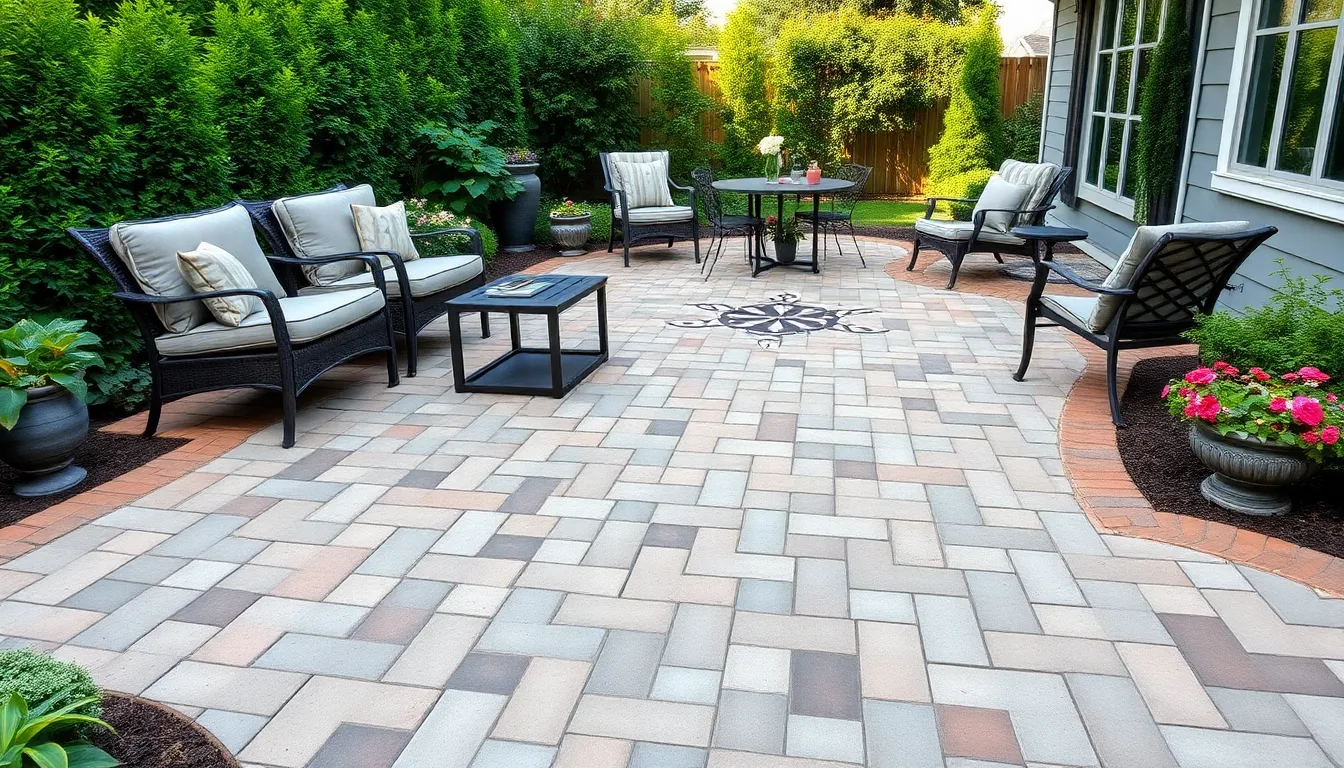
Borders and accent patterns transform our 24×24 paver patio from basic to breathtaking by adding visual definition and architectural interest. We can create stunning focal points that complement our multi-level designs while improving the overall flow of our outdoor space.
Contrasting Color Border Designs
We achieve dramatic visual impact by selecting border colors that sharply contrast with our main paver field. Dark borders paired with light field pavers create bold definition, while warm border tones combined with cool field colors add sophisticated depth to our 24×24 space.
Matching our border colors to existing home elements like roofing, industry rock, or architectural details creates cohesive visual ties throughout our outdoor design. We recommend using soldier course borders with rectangular pavers placed side by side for clean linear framing around our patio perimeter.
Double border combinations offer layered sophistication by incorporating both complementary and contrasting colors in our design scheme. Sailor course borders laid lengthwise provide opportunities to incorporate multiple paver types, creating added visual interest that enhances our entertaining space.
Decorative Inlay Patterns
Inlay patterns serve as artistic focal points embedded within our patio floor using contrasting paver colors or sizes. We can create geometric shapes like diamonds, squares, or circles that highlight exact seating areas or pathways within our 24×24 layout.
Nature inspired motifs such as leaves or floral patterns add organic beauty to our hardscape design. Custom inlay designs customized to match our architectural style transform ordinary paver installations into personalized outdoor art pieces.
Strategic placement of inlays helps organize different activity zones within our patio space. We position these decorative elements to guide traffic flow while creating visual breaks that prevent large paver expanses from appearing monotonous.
Mixed Size Paver Accents
Combining different paver sizes enhances texture and depth by breaking the uniformity of our 24×24 installation. We incorporate smaller accent pavers within the main field to create dimensional interest that catches the eye and adds sophisticated detail.
Running bond patterns with larger accent stones provide creative opportunities for unique installations. Small mosaic style inserts work particularly well in border areas, creating transitional elements between our main paving and industry features.
Accent pavers interspersed throughout our main field break visual monotony while adding focal points with different colors or textures. We use this technique in both field areas and borders to emphasize exact zones within our patio, creating an captivating hardscape that transforms our backyard into a distinctive outdoor living space.
Natural Stone Look Paver Options
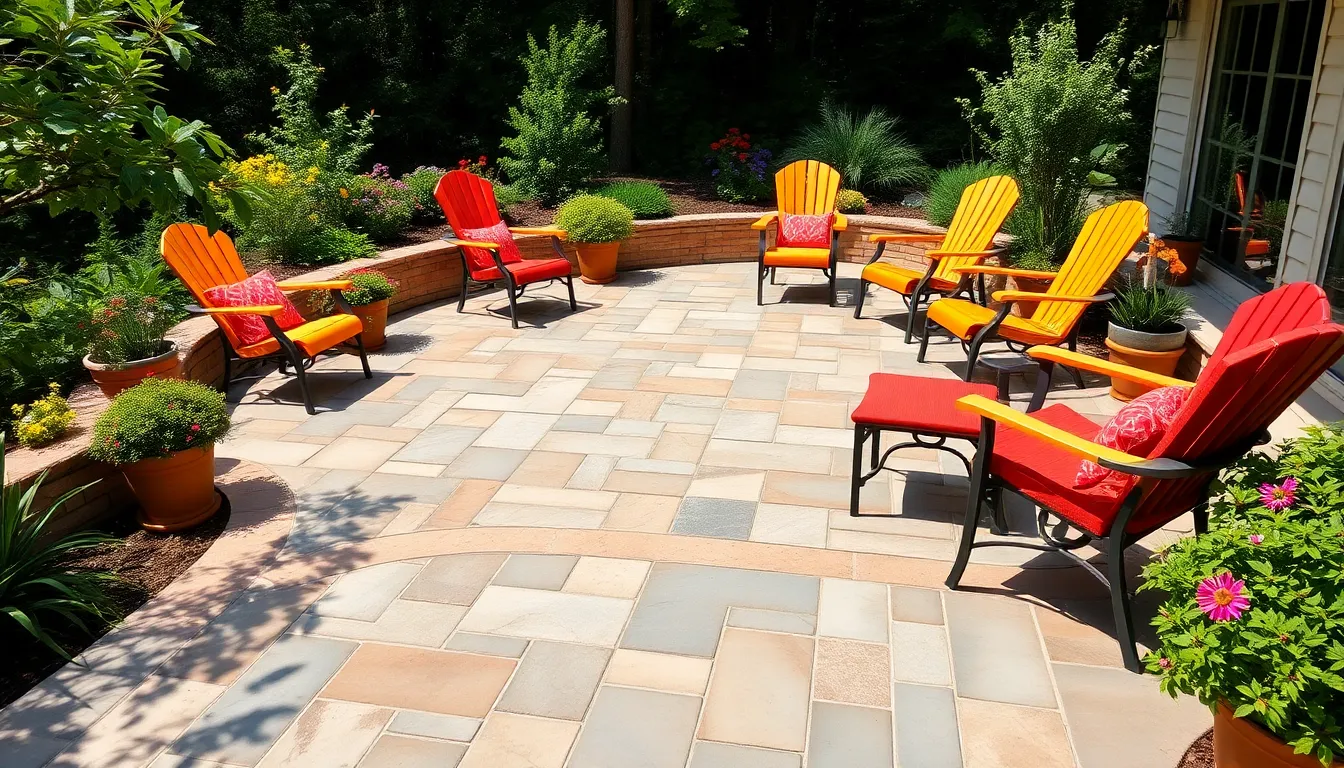
We’ve explored various patterns and layouts, but the material choice significantly impacts your patio’s final aesthetic. Natural stone look pavers deliver the timeless elegance of authentic stone while offering superior durability and consistent sizing that 24×24 formats provide.
Slate Texture 24×24 Pavers
Slate textured pavers bring sophisticated depth to your 24×24 patio through their distinctive rough surfaces and rich color variations. Deep grays, moody blues, and forest greens create an authentic stone appearance that naturally complements both rustic and contemporary outdoor settings. These pavers feature subtle undulations and mineral streaking that mimics genuine slate’s weathered character.
Installing slate texture pavers requires attention to their naturally varied surface heights, which enhance slip resistance while creating visual interest. We recommend selecting pavers with consistent thickness even though surface texture variations to ensure proper installation. The slightly raised texture patterns catch light differently throughout the day, creating ever-changing shadows that add movement to your patio surface.
Maintenance for slate textured pavers involves regular sweeping to prevent debris accumulation in surface crevices, though their dark coloring effectively hides everyday wear and staining.
Sandstone Finish Designs
Sandstone inspired pavers showcase warm, earthy tones including rich tans, creamy beiges, and soft terracotta reds that bring natural warmth to your outdoor space. Their smooth yet slightly weathered surface texture replicates authentic sandstone’s porous appearance while maintaining the structural integrity needed for high traffic areas. This finish works exceptionally well in Mediterranean and traditional patio designs where natural stone aesthetics are prioritized.
Color blending techniques allow you to mix multiple sandstone tones within your 24×24 layout, creating organic variation that mirrors natural stone deposits. We suggest incorporating lighter sandstone shades near seating areas to reflect heat, while using deeper tones for accent borders or pathways.
The matte finish of sandstone look pavers reduces glare during sunny days, making them comfortable for barefoot use around pools or dining areas. Their neutral color palette serves as an excellent backdrop for colorful outdoor furniture and vibrant landscaping elements.
Limestone Appearance Patterns
Limestone look pavers offer refined elegance through their uniform, matte finish in sophisticated light grays and warm creams. These pavers create a classic, stately appearance that seamlessly blends with both formal garden settings and minimalist outdoor designs. Their consistent coloring and smooth texture provide a perfect foundation for showcasing architectural elements and industry features.
Planning limestone pattern layouts involves considering the stone’s natural bedding planes, which manufacturers replicate through subtle linear markings across paver surfaces. We recommend arranging these pavers to align grain patterns for a cohesive look, or alternating grain directions to create subtle geometric interest within your 24×24 space.
Limestone appearance pavers complement metal outdoor furniture and contemporary water features exceptionally well, while their light coloring helps smaller patios appear more spacious. Their neutral tones serve as an ideal canvas for seasonal decorating and allow colorful plantings to truly pop against the understated background.
Modern Minimalist Patio Layouts
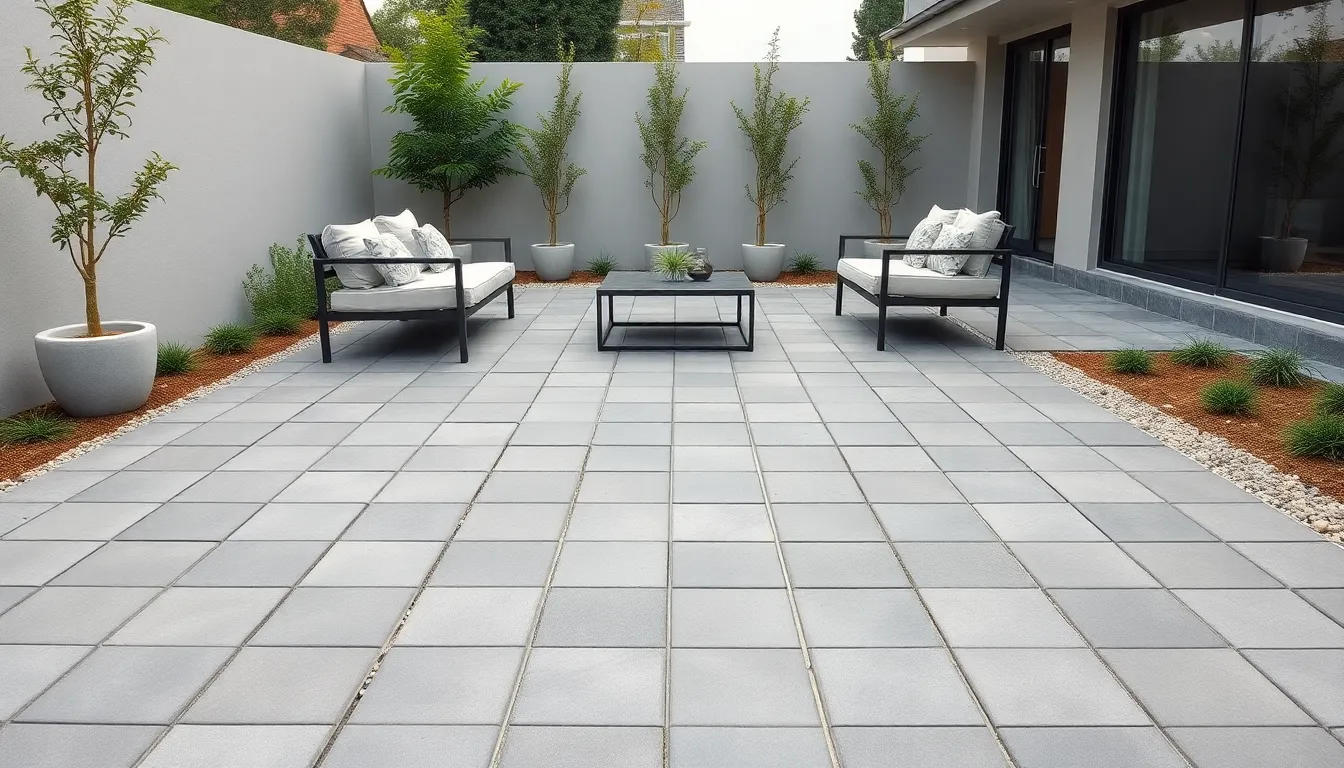
After exploring various patterns and materials, we’re shifting focus to contemporary design approaches that emphasize simplicity and functionality. Modern minimalist 24×24 paver patios create serene outdoor spaces through deliberate restraint and thoughtful design choices.
Clean Grid Pattern Design
Clean grid patterns form the foundation of successful minimalist patio designs using 24×24 pavers. We achieve visual order by laying pavers in precise square or rectangular alignments that emphasize geometric clarity. The large format of these pavers naturally reduces grout lines, creating seamless surfaces that promote the uncluttered aesthetic essential to minimalist design.
Strategic joint treatment enhances the grid’s visual impact without compromising simplicity. We recommend filling joints with narrow gravel, grass, or ground cover plants to add subtle texture while maintaining the pattern’s clarity. Even spacing between pavers ensures the grid maintains its balanced, orderly appearance throughout the 576 square foot space.
Installation precision becomes critical for achieving the clean lines that define this approach. We position each paver with meticulous attention to alignment, ensuring consistent spacing and perfect right angles. The resulting pattern creates a sense of calm and promotes the spacious feel that makes minimalist patios so appealing.
Monochromatic Color Schemes
Monochromatic palettes using shades of gray, black, white, or earth tones reinforce the minimalist philosophy in 24×24 paver installations. We select consistent tones or closely related hues that contribute to sophisticated and tranquil environments without visual clutter.
Gray variations offer the most versatility for modern minimalist designs, ranging from light dove gray to deep charcoal. We often specify mid tone grays that provide enough contrast for definition while maintaining the subtle sophistication that characterizes this design approach. These neutral backgrounds allow furniture, plants, or architectural features to serve as focal points.
Earth tone monochromatic schemes work particularly well when connecting to natural surroundings. We use warm beiges, soft taupes, or cool stone colors that blend harmoniously with existing industry elements. The key lies in selecting pavers with minimal color variation within the chosen hue family to maintain the clean, cohesive appearance.
Simplified Geometric Arrangements
Simplified geometric arrangements maximize the impact of 24×24 pavers through modular layouts that emphasize structure and harmony. We create visual interest by combining large square shapes with rectangular or linear elements while maintaining geometric simplicity.
Geometric repetition using large scale paver shapes establishes visual rhythm without complexity. We often arrange pavers in repeating modules of four or nine squares, creating larger geometric units that maintain the minimalist aesthetic. These arrangements can incorporate subtle variations in orientation or spacing to prevent monotony while preserving clean lines.
Strategic integration of minimalist landscaping or accent lighting enhances the geometric focus without overwhelming the design. We position simple plantings or linear light fixtures to complement the paver arrangement, reinforcing the architectural precision that defines modern minimalist outdoor spaces. The resulting designs achieve functional beauty through deliberate simplicity and thoughtful proportion.
Creative Color Combination Ideas
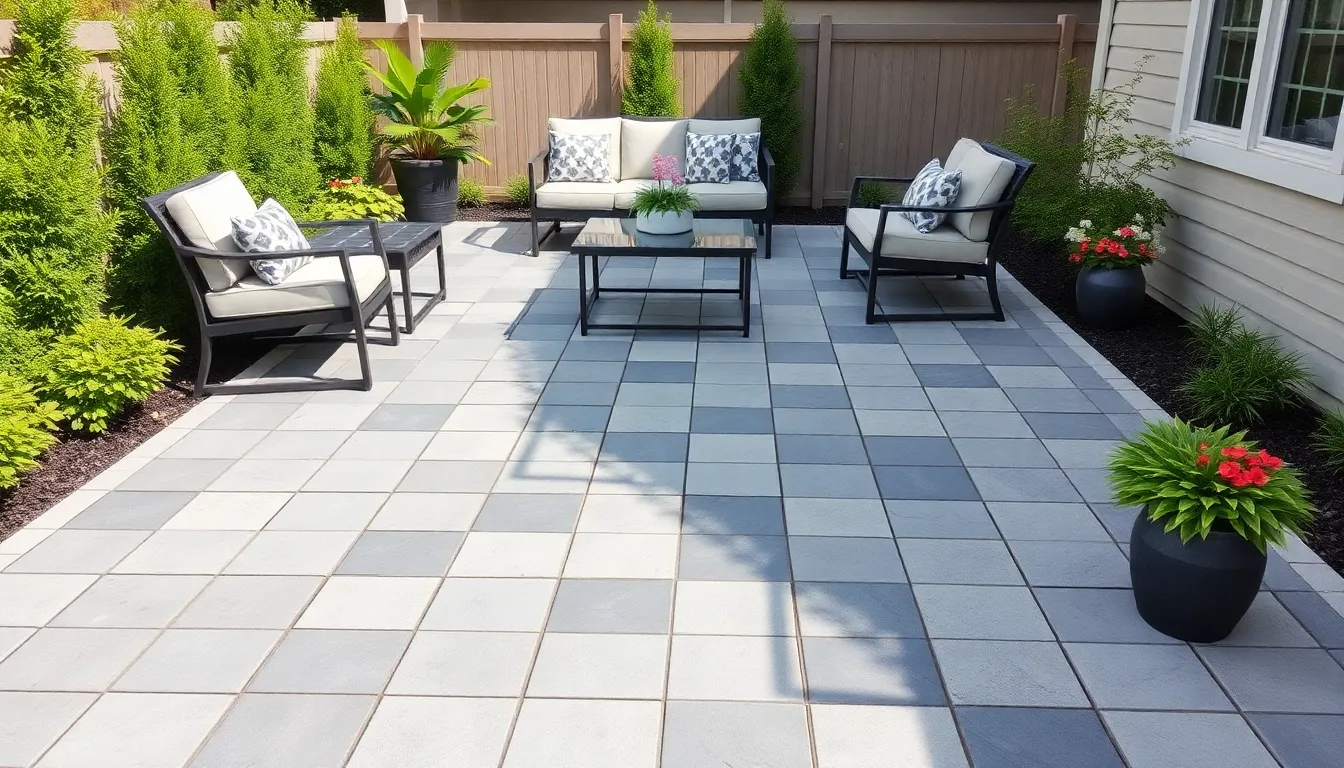
We can transform our 24×24 paver patio into a stunning outdoor masterpiece by exploring diverse color palettes that enhance both functionality and aesthetic appeal. Color combinations offer endless possibilities to create unique outdoor spaces that reflect our personal style while complementing our home’s architecture.
Two-Tone Checkerboard Patterns
Checkerboard layouts create geometric interest through alternating color placement that brings classic appeal to our patio design. Pairing contrasting colors like charcoal gray with light cream delivers a timeless look that suits both modern and traditional outdoor spaces. Rusty orange alternating with sand beige offers another stunning combination that adds warmth while maintaining visual balance.
We recommend laying these 24×24 pavers in a precise grid pattern to achieve the cleanest appearance. Spacing between pavers should remain consistent to emphasize the checkerboard effect and prevent visual disruption. This pattern injects rhythm and definition without overwhelming our outdoor entertaining space.
Gradient Color Transitions
Gradient effects transform our patio surface through gradual color shifts from darker to lighter tones across the entire area. Selecting several shades within the same color family creates seamless transitions that add visual depth and movement. Dark slate progressing to light gray exemplifies how ombre techniques can make our patio feel larger and more ever-changing.
We achieve the best results by planning our gradient layout before installation begins. Starting with the darkest pavers along one edge and gradually introducing lighter shades creates natural flow throughout the space. The 24×24 size maintains consistency in the gradient’s appearance while providing sufficient surface area for the color transition to develop naturally.
Bold Contrast Combinations
Bold contrasts create striking visual impact through dramatic color pairings that emphasize the geometric edges of our large pavers. Black and white combinations deliver maximum contrast while deep charcoal paired with bright yellow creates contemporary appeal that defines exact zones within our patio design. These high contrast approaches work exceptionally well with modern aesthetics and clean lined outdoor furniture.
We can use contrasting colors to delineate seating areas from walkways or create focal points around fire pits and outdoor kitchens. The sharp color demarcations benefit from sleek furniture choices that complement the geometric precision. Our 24×24 pavers provide the perfect canvas for these bold statements while maintaining structural consistency throughout the installation.
Outdoor Living Space Integration
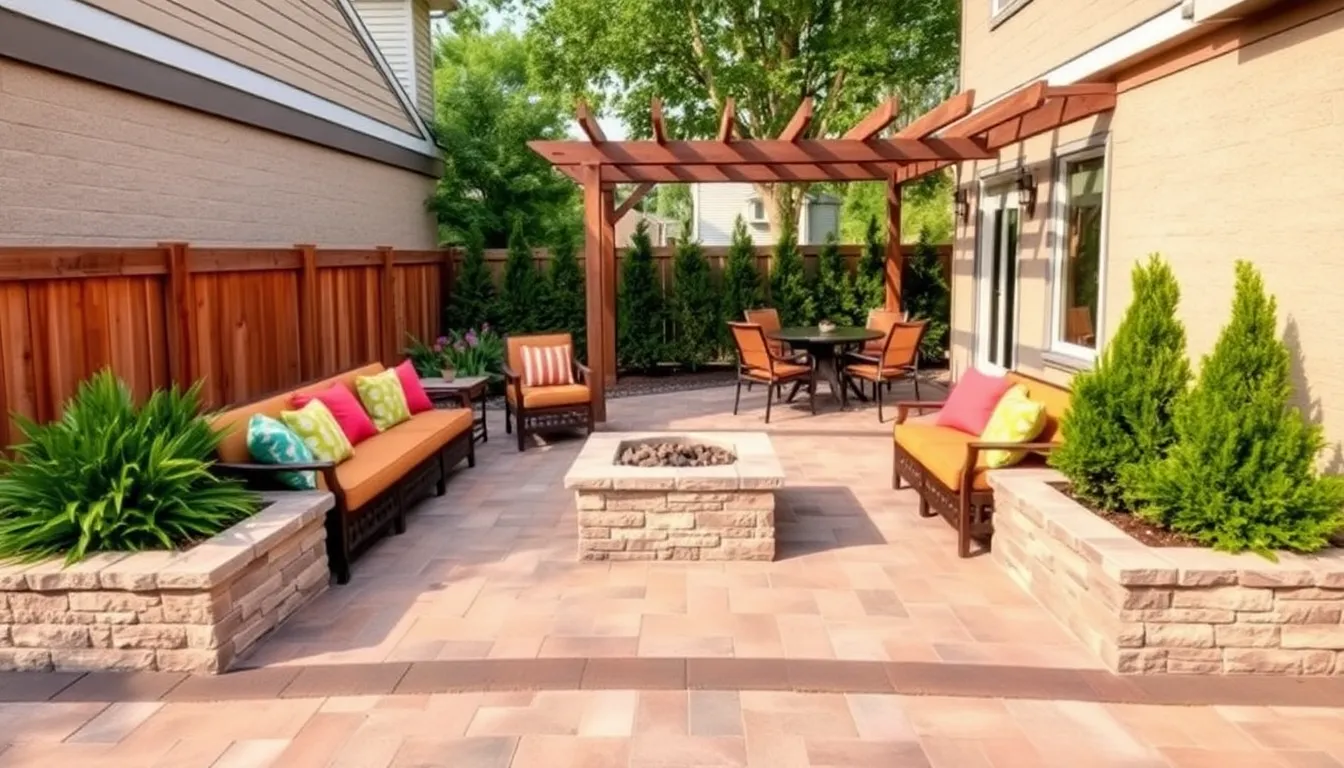
A 24×24 paver patio transforms into the ultimate outdoor living hub when we strategically integrate multiple functional zones that encourage year-round use and entertaining.
Fire Pit Focal Point Areas
Fire pits create natural gathering spots that anchor our patio design and extend usability throughout the seasons. Positioning the fire pit at the center or along one edge of our 24×24 space establishes a visual focal point while maximizing the surrounding paver surface for safety and functionality. We recommend arranging seating in a semi-circle around the fire feature to promote conversation and ensure everyone enjoys the warmth equally.
Safety considerations make pavers the ideal choice for fire pit surroundings since they provide a durable, heat-resistant surface that won’t crack or warp under temperature changes. Strategic lighting around the fire pit area enhances ambiance after dark and creates dramatic shadows across the paver surface. Built-in features like log storage or side tables integrated into the paver design keep essentials within reach while maintaining the clean aesthetic.
Built-In Seating Designs
Built-in seating maximizes our patio’s functionality while creating cohesive design elements that feel intentional rather than scattered. Low retaining walls constructed from matching concrete pavers or complementary natural stone serve the dual purpose of defining space boundaries and providing comfortable seating options. Custom sizing allows us to fit seating perfectly within our 24×24 dimensions without overwhelming the space.
Cushions and outdoor pillows transform basic built-in elements into comfortable gathering spots that invite extended use. Strategic placement along the patio perimeter keeps the central area open for movement and activities while encouraging social interaction. We suggest incorporating planters between seating sections to add greenery and create natural divisions without blocking sightlines.
Dining Area Configurations
Dining areas within our 24×24 patio accommodate tables for 4-6 people while leaving adequate space for movement and additional features. Positioning the dining zone near sliding doors or outdoor kitchens enhances convenience for food service and indoor-outdoor flow. Weather-resistant furniture scaled appropriately for the patio dimensions ensures functionality without creating a cramped feeling.
Shade options like pergolas or umbrellas improve dining comfort during peak sun hours and add vertical interest to the patio design. Orienting the dining area toward garden views or architectural features creates pleasant focal points for meals and conversation. Strategic placement allows the dining zone to coexist harmoniously with fire pit areas and built-in seating, creating distinct yet connected outdoor living zones.
Low-Maintenance Design Solutions
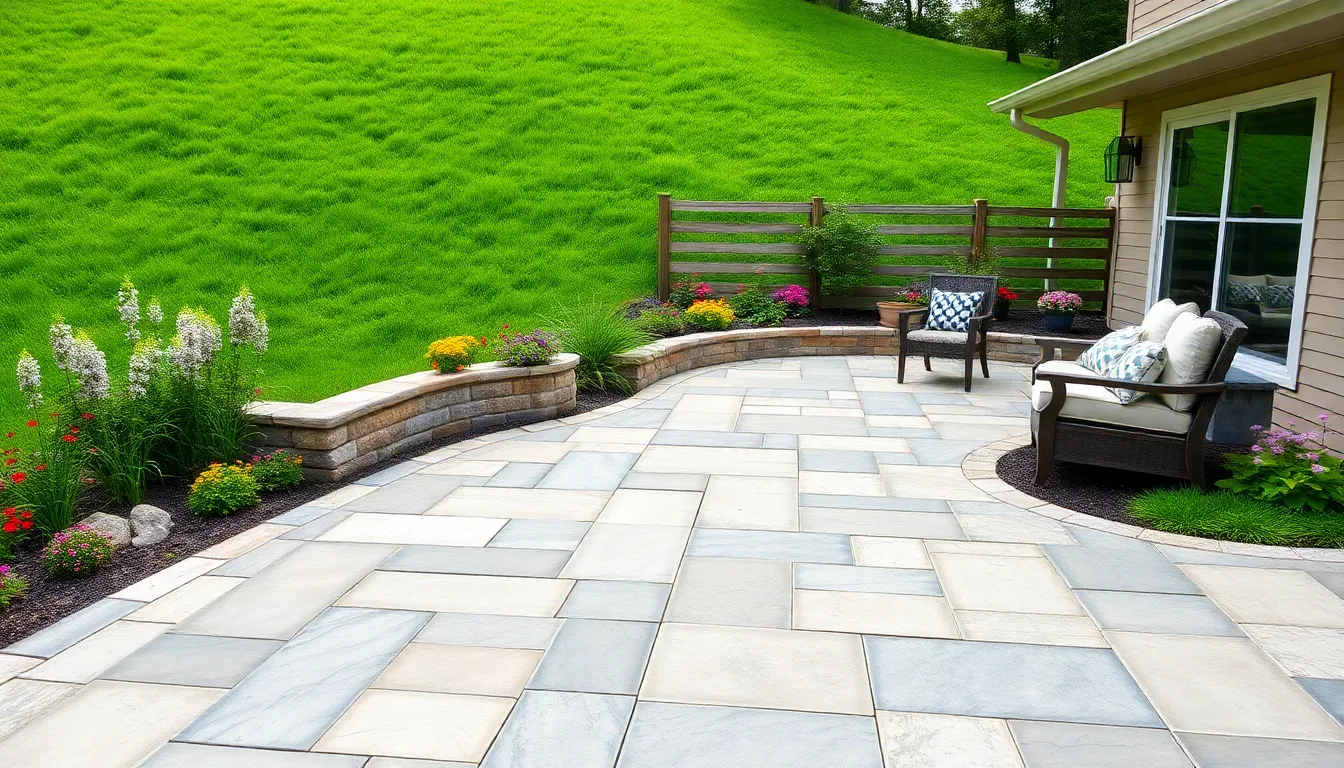
Creating a 24×24 paver patio that requires minimal upkeep transforms your outdoor space into a functional retreat without the constant maintenance burden. Smart design choices and material selection make the difference between a high-maintenance headache and a carefree entertaining area.
Permeable Paver Options
Permeable pavers revolutionize traditional patio design by allowing water to drain naturally through the surface, reducing runoff and promoting healthy landscaping around your patio area. Natural stone options like quartzite provide the perfect balance between durability and permeability, handling heavy foot traffic while managing rainwater effectively.
Installing permeable systems supports environmental sustainability by managing rainwater onsite, helping prevent erosion and flooding issues that plague traditional solid surfaces. These eco-friendly answers eliminate standing water problems that create maintenance headaches and mosquito breeding grounds.
Water management becomes effortless when you choose permeable pavers that work with your industry rather than against it. The natural drainage reduces the need for additional drainage systems and keeps your patio surface dry and usable even after heavy rains.
Easy-Clean Surface Treatments
Porcelain and tumbled travertine pavers earn top marks for effortless cleaning, withstanding annual power washing without damage or surface degradation. These materials resist staining and dirt accumulation, making routine maintenance as simple as a once-yearly deep clean.
Surface treatments that seal pavers create protective barriers against spills, weather damage, and everyday wear, significantly reducing cleaning time and effort. Quality sealers prevent dirt from penetrating the paver surface, allowing most stains to wipe away with basic cleaning answers.
Stone patios featuring quartzite or porcelain materials resist wear patterns and maintain their appearance with minimal intervention, requiring only occasional power washing to restore their original beauty. Regular sweeping and prompt spill cleanup keep these surfaces looking pristine year round.
Weather-Resistant Pattern Choices
Geometric patterns including triangles, diamonds, and checkerboard layouts mask natural wear and dirt accumulation while maintaining their timeless visual appeal through various weather conditions. These designs hide imperfections and wear patterns that become obvious in simpler layouts.
Circular patios and multi-level designs promote natural water runoff during rain events, minimizing pooling and surface damage that leads to costly repairs. Strategic elevation changes guide water away from seating areas and toward landscaped drainage zones.
Classic crosshatch woven patterns add texture and traditional charm while proving straightforward to install and resilient against weather effects that challenge more complex designs. The interlocking nature of these patterns distributes weight evenly and prevents individual paver movement during freeze-thaw cycles.
Designs using large 16×16 or 24×24 pavers combined with contrasting materials like black marble chips provide visually appealing surfaces that simplify maintenance through reduced grout lines. Incorporating clean lines and pairing pavers with turf or minimal greenery reduces garden care requirements while maintaining an inviting aesthetic that welcomes guests year round.
Conclusion
We’ve shown you that a 24×24 paver patio offers endless possibilities for creating your perfect outdoor retreat. Whether you’re drawn to classic herringbone patterns or modern geometric designs this size provides the ideal canvas for your vision.
The key to success lies in thoughtful planning and selecting elements that reflect your lifestyle. From fire pit focal points to built-in seating areas every design choice should enhance how you’ll actually use the space.
Remember that the best patio designs combine beauty with practicality. Choose materials and patterns that align with your maintenance preferences while creating the atmosphere you want for entertaining and relaxation.
Your 24×24 paver patio can become the heart of your outdoor living experience. With the right design approach you’ll create a space that brings lasting joy and adds important value to your home.
Frequently Asked Questions
What size is a 24×24 paver patio?
A 24×24 paver patio provides 576 square feet of outdoor space. This generous size allows for various furniture arrangements while maintaining an intimate atmosphere, making it ideal for outdoor entertaining and family gatherings.
What are the most popular paver patterns for a 24×24 patio?
Popular patterns include herringbone (classic and modern), linear stack patterns, running bond layouts, and geometric arrangements. Circular and curved designs are also trending, offering elegant focal points and sophisticated outdoor spaces.
How much does a 24×24 paver patio cost?
While specific costs aren’t provided in the article, a 24×24 paver patio offers an excellent balance between functionality and affordability. Costs vary based on paver material, pattern complexity, and installation requirements.
What materials work best for 24×24 paver patios?
Natural stone look pavers, slate texture pavers, sandstone finishes, and limestone appearance patterns are excellent choices. These materials combine the elegance of authentic stone with durability in the 24×24 format.
Can I install different functional zones in a 24×24 patio?
Yes, the 576 square feet can accommodate multiple zones including fire pit areas, built-in seating, and dining spaces for 4-6 people. Strategic placement and design elements create distinct areas while maintaining cohesion.
What are the best low-maintenance paver options?
Permeable pavers, porcelain surfaces, and tumbled travertine offer excellent durability and easy cleaning. Weather-resistant patterns like geometric designs and crosshatch patterns help mask wear and dirt accumulation.
How do I choose colors for my paver patio?
Consider two-tone checkerboard patterns, gradient color transitions, or bold contrast combinations. Monochromatic schemes using grays, blacks, whites, or earth tones work well for modern minimalist designs.
Can I create curved designs with large pavers?
Yes, circular and semi-circular layouts are possible with 24×24 pavers. These designs require precise cutting along curved edges and careful planning, but create dramatic focal points and intimate gathering spaces.

